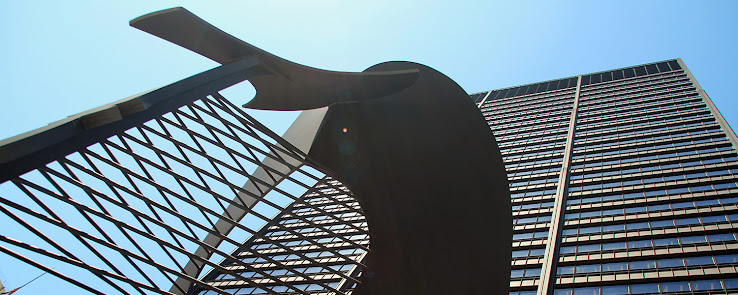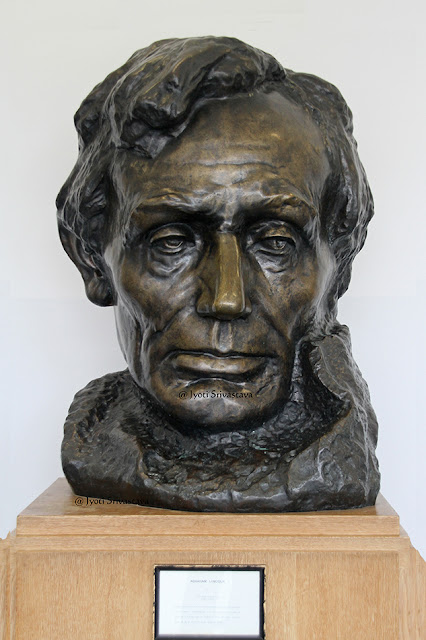Left panels [music and painting]..
Center panels [literature and architecture]..
Right panels [theater and dance]..
Art Institute of Chicago [AIC]..
Reinstallation of The America Windows,
Originally created: 1975-77..
By Marc Chagall..
Commemorating the American Bicentennial in memory of Mayor Richard J. Daley..
Originally installed: May 15, 1977...
Reinstalled: Nov 1, 2010..
The marker reads..
At the end of World War - II, Marc Chagall sought new avenues for artistic experimentation and turned to the medium of stained glass, which allowed him to explore color on a monumental scale. Working with master stained glass maker Charles Marq, he executed 86 windows across Europe, Israel and the US. American Windows present an unusual secular theme in his oeuvre, merging symbols of American history, the Chicago skyline and the arts; reading from left to right, the panels represent music, painting, literature, architecture, theater and dance.
Details: Left panels [music and painting]..
Details: Left panels [music and painting]..
Details: Left panels [music and painting]
Details: Center panels [literature and architecture]..
Details: Center panels [literature and architecture]..
Details: Right panels [theater and dance]..
Details: Right panels [theater and dance]..
Details: Right panels [theater and dance]..
Chagall dedicated his work to Mayor Richard J. Daley, a great supporter of public art projects in the city, with whom he had worked in the city on The Four Seasons mosaic at Chase Tower Plaza [image below]..

For more.. click on the link..
Mosaic "Four Seasons" - by Marc Chagall.. at Exelon Plaza / Chase Tower Plaza..
Excerpt from the AIC website....
While members and visitors have loved America Windows for years, many may not realize how deeply their history is interwoven with the history of Chicago and its rich tradition of public art. The story begins in the early 1970s, when Chagall came to the city for work related to his mosaic installed outside Chase Tower, The Four Seasons. In response to the city’s enthusiasm for his work and the Art Institute’s great support, the artist offered to create a set of stained-glass windows for the museum. Over the course of three years, plans were clarified, and in the end, Chagall determined that the windows would commemorate America’s bicentennial. The resulting six-panel work celebrates the country as a place of cultural and religious freedom, detailing the arts of music, painting, literature, theater, and dance. Because of his admiration for Chicago and its strong commitment to public art during the 1960s and 1970s, Chagall chose to dedicate the work to Mayor Richard J. Daley, a great supporter of public art projects. The windows were presented with much fanfare at a formal unveiling, hosted by the Auxiliary Board of the Art Institute, on May 15, 1977...
The marker reads,
The roots of Marc Chagall's America Windows could rightly be traced to 1967 - the year Pablo Picasso's monumental sculpture in Chicago's civic center [now called the Richard J. Daley Center] was unveiled. Insightfully, Mayor Richard J. Daley dedicated the sculpture with the owrds, "What is strange to us today will be familiar tomorrow." Today Chicago's great collection of public art is one of the defining characteristics of the city...
Continue reading.. click here..



























































